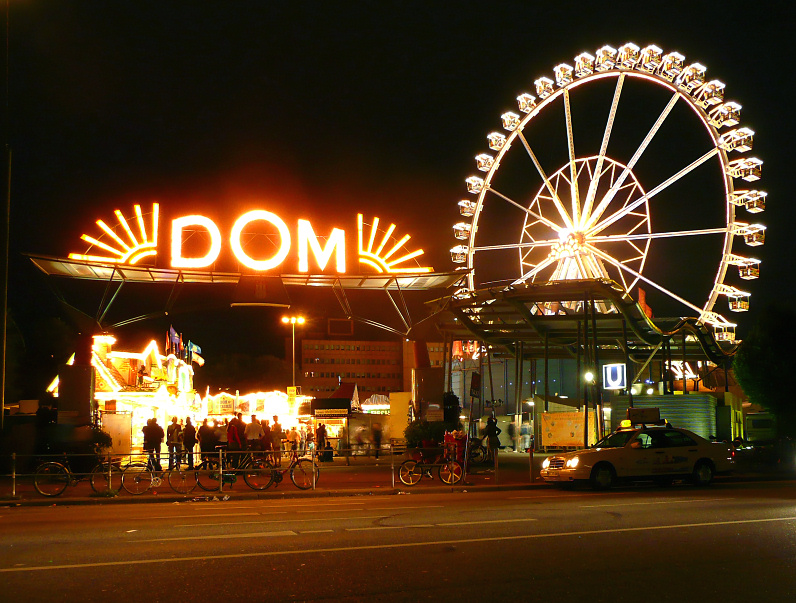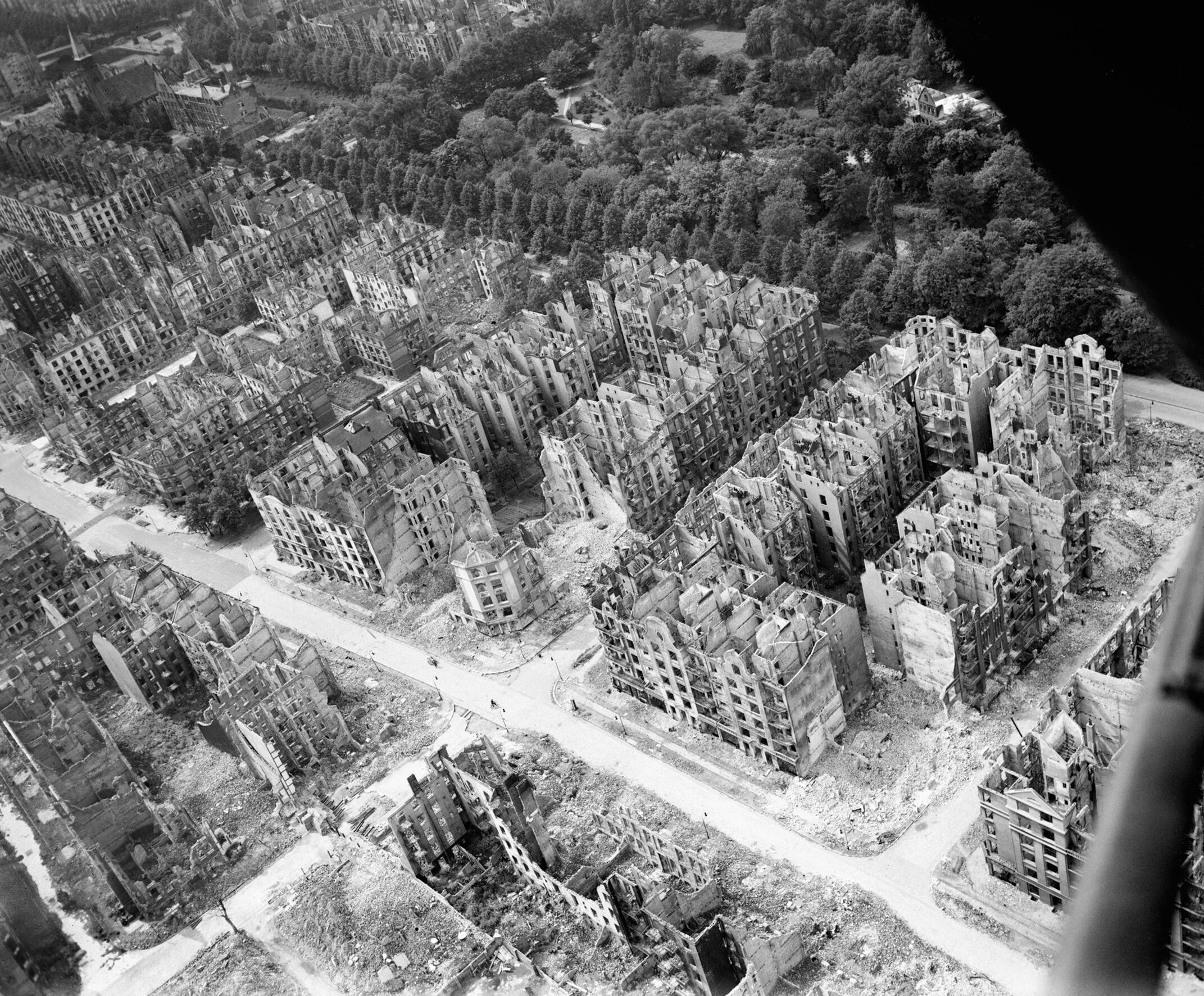|
Heiligengeistfeld
Heiligengeistfeld (German: "Holy Ghost Field") is an area of Hamburg in the St. Pauli quarter. The ''Hamburger Dom'' funfair has been held there since 1893. When the area is not used for exhibitions, circuses or the Dom it is a car park. A building from German Telekom, a swimming complex, Millerntor-Stadion, a school, a patrol station, a World War II building (''Flakturm'' IV) and a supermarket are permanent structures on the field. History The area was named after a hospital in 1497, forming a kind of green as part of the hospital's endowment to make up for its maintenance. The area has been used for exhibitions since 1863. With the intensifying Allied bombing of Hamburg the "Flak tower" Flakturm IV structure was erected on Heiligengeistfeld starting in 1942. It was both an anti-aircraft gun emplacement and air-raid shelter. The massive concrete structure is still standing. The area is noteworthy in music history for being the location where German photographer Astrid K ... [...More Info...] [...Related Items...] OR: [Wikipedia] [Google] [Baidu] |
Millerntor-Stadion
Millerntor-Stadion () is a multi-purpose stadium in the St. Pauli area of Hamburg, Germany. Best known as the home ground of football club FC St. Pauli, it is on the Heiligengeistfeld near the Reeperbahn, the red light district of Hamburg. The stadium had a capacity of 32,000 when it was built in 1961. It is also used by the Blue Devils American football team, and as a concert venue, including a performance by Prince in 1988. FC St Pauli celebrated their centenary festival at the stadium in 2010. History The first sports ground at the Heiligengeistfeld was created after the First World War as a simple flat space. This was the home ground of the ''St. Pauli TV'', together with other workers sports associations (''Arbeitersportkartells''). In 1946, the club (now called ''FC St. Pauli'') built its own stadium partially on the original site of Hamburg Observatory, built in 1802 by Johann Georg Repsold and moved to Bergedorf in 1912. The stadium was located on the Heiligengeistfeld ... [...More Info...] [...Related Items...] OR: [Wikipedia] [Google] [Baidu] |
Flak Tower
Flak towers (german: link=no, Flaktürme) were large, above-ground, anti-aircraft gun blockhouse towers constructed by Nazi Germany. There were 8 flak tower complexes in the cities of Berlin (three), Hamburg (two), and Vienna (three) from 1940 onwards. Other cities that used flak towers included Stuttgart and Frankfurt. Smaller single-purpose flak towers were built at key outlying German strongpoints, such as at Angers in France, and Helgoland in Germany. The towers were operated by the Luftwaffe to defend against Allied strategic air raids against these cities during World War II. They also served as air-raid shelters for tens of thousands of local civilians. History and uses After the RAF's raid on Berlin in 1940, Adolf Hitler ordered the construction of three massive flak towers to defend the capital from air attack. Each tower had a radar installation with a radar dish which could be retracted behind a thick concrete and steel dome for protection. Hitler was interested ... [...More Info...] [...Related Items...] OR: [Wikipedia] [Google] [Baidu] |
Hamburger Dom
The Hamburger Dom is a large fair held at Heiligengeistfeld fair ground in central Hamburg, Germany. With three fairs (spring, summer and winter) per year it is the biggest and the longest fair throughout Germany and attracts approximately ten million visitors per year. It is also referred to as a Volksfest (beer festival and travelling funfair).The Hamburger Dom is also one of the well known festivals in the Hamburg metropolitan area. Hamburger Dom puts on an impressive firework display at the Heiligengeistfeld, that can be seen across most of the city, every Friday that it runs at 22:30 hrs. On the Winterdom 2021 was a laser-show set up for the first time History A market in or in front of Hamburg's Cathedral (german: Hamburger Dom) was first recorded in 1329, at the beginning only in special seasons like Christmas. With the Protestant Reformation in the 16th century the fair was also held at other times. After the demolition of the cathedral (1804–1807), the market ... [...More Info...] [...Related Items...] OR: [Wikipedia] [Google] [Baidu] |
Hamburg
(male), (female) en, Hamburger(s), Hamburgian(s) , timezone1 = Central (CET) , utc_offset1 = +1 , timezone1_DST = Central (CEST) , utc_offset1_DST = +2 , postal_code_type = Postal code(s) , postal_code = 20001–21149, 22001–22769 , area_code_type = Area code(s) , area_code = 040 , registration_plate = , blank_name_sec1 = GRP (nominal) , blank_info_sec1 = €123 billion (2019) , blank1_name_sec1 = GRP per capita , blank1_info_sec1 = €67,000 (2019) , blank1_name_sec2 = HDI (2018) , blank1_info_sec2 = 0.976 · 1st of 16 , iso_code = DE-HH , blank_name_sec2 = NUTS Region , blank_info_sec2 = DE6 , website = , footnotes ... [...More Info...] [...Related Items...] OR: [Wikipedia] [Google] [Baidu] |
Hamburg Medienbunker 01 KMJ
(male), (female) en, Hamburger(s), Hamburgian(s) , timezone1 = Central (CET) , utc_offset1 = +1 , timezone1_DST = Central (CEST) , utc_offset1_DST = +2 , postal_code_type = Postal code(s) , postal_code = 20001–21149, 22001–22769 , area_code_type = Area code(s) , area_code = 040 , registration_plate = , blank_name_sec1 = GRP (nominal) , blank_info_sec1 = €123 billion (2019) , blank1_name_sec1 = GRP per capita , blank1_info_sec1 = €67,000 (2019) , blank1_name_sec2 = HDI (2018) , blank1_info_sec2 = 0.976 · 1st of 16 , iso_code = DE-HH , blank_name_sec2 = NUTS Region , blank_info_sec2 = DE6 , website = , footnotes ... [...More Info...] [...Related Items...] OR: [Wikipedia] [Google] [Baidu] |
Geography Of Hamburg
Hamburg (, ; nds, label=Hamburg German, Low Saxon, Hamborg ), officially the Free and Hanseatic City of Hamburg (german: Freie und Hansestadt Hamburg; nds, label=Low Saxon, Friee un Hansestadt Hamborg),. is the List of cities in Germany by population, second-largest city in Germany after Berlin, as well as the overall List of cities in the European Union by population within city limits, 7th largest city and largest non-capital city in the European Union with a population of over 1.85 million. Hamburg's urban area has a population of around 2.5 million and is part of the Hamburg Metropolitan Region, which has a population of over 5.1 million people in total. The city lies on the River Elbe and two of its tributaries, the River Alster and the Bille (Elbe), River Bille. One of Germany's 16 States of Germany, federated states, Hamburg is surrounded by Schleswig-Holstein to the north and Lower Saxony to the south. The official name reflects History of Hamburg, Hamburg's history ... [...More Info...] [...Related Items...] OR: [Wikipedia] [Google] [Baidu] |
Holy Spirit
In Judaism, the Holy Spirit is the divine force, quality, and influence of God over the Universe or over his creatures. In Nicene Christianity, the Holy Spirit or Holy Ghost is the third person of the Trinity. In Islam, the Holy Spirit acts as an agent of divine action or communication. In the Baha’i Faith, the Holy Spirit is seen as the intermediary between God and man and "the outpouring grace of God and the effulgent rays that emanate from His Manifestation". Comparative religion The Hebrew Bible contains the term " spirit of God" (''ruach hakodesh'') which by Jews is interpreted in the sense of the might of a unitary God. This interpretation is different from the Christian conception of the Holy Spirit as one person of the Trinity. The Christian concept tends to emphasize the moral aspect of the Holy Spirit more than Judaism, evident in the epithet Spirit that appeared in Jewish religious writings only relatively late but was a common expression in the Christian Ne ... [...More Info...] [...Related Items...] OR: [Wikipedia] [Google] [Baidu] |
Village Green
A village green is a common open area within a village or other settlement. Historically, a village green was common grassland with a pond for watering cattle and other stock, often at the edge of a rural settlement, used for gathering cattle to bring them later on to a common land for grazing. Later, planned greens were built into the centres of villages. The village green also provided, and may still provide, an open-air meeting place for the local people, which may be used for public celebrations such as May Day festivities. The term is used more broadly to encompass woodland, moorland, sports grounds, buildings, roads and urban parks. History Most village greens in England originated in the Middle Ages. Individual greens may have been created for various reasons, including protecting livestock from wild animals or human raiders during the night, or providing a space for market trading. In most cases where a village green is planned, it is placed in the centre of a settle ... [...More Info...] [...Related Items...] OR: [Wikipedia] [Google] [Baidu] |
Allies Of World War II
The Allies, formally referred to as the United Nations from 1942, were an international military coalition formed during the Second World War (1939–1945) to oppose the Axis powers, led by Nazi Germany, Imperial Japan, and Fascist Italy. Its principal members by 1941 were the United Kingdom, United States, Soviet Union, and China. Membership in the Allies varied during the course of the war. When the conflict broke out on 1 September 1939, the Allied coalition consisted of the United Kingdom, France, and Poland, as well as their respective dependencies, such as British India. They were soon joined by the independent dominions of the British Commonwealth: Canada, Australia, New Zealand and South Africa. Consequently, the initial alliance resembled that of the First World War. As Axis forces began invading northern Europe and the Balkans, the Allies added the Netherlands, Belgium, Norway, Greece, and Yugoslavia. The Soviet Union, which initially had a nonaggression pa ... [...More Info...] [...Related Items...] OR: [Wikipedia] [Google] [Baidu] |
Bombing Of Hamburg In World War II
The Allied bombing of Hamburg during World War II included numerous attacks on civilians and civic infrastructure. As a large city and industrial centre, Hamburg's shipyards, U-boat pens, and the Hamburg-Harburg area oil refineries were attacked throughout the war. As part of a sustained campaign of strategic bombing during World War II, the attack during the last week of July 1943, code named Operation Gomorrah, created one of the largest firestorms raised by the Royal Air Force and United States Army Air Forces in World War II, killing an estimated 37,000 civilians and wounding 180,000 more in Hamburg, and virtually destroying most of the city. Hamburg was selected as a target because it was considered particularly susceptible to attack with incendiaries, which, from the experience of the Blitz, were felt to inflict more damage than just high explosive bombs. Hamburg also contained a high number of targets supporting the German war effort and was relatively easy for na ... [...More Info...] [...Related Items...] OR: [Wikipedia] [Google] [Baidu] |
Anti-aircraft Gun
Anti-aircraft warfare, counter-air or air defence forces is the battlespace response to aerial warfare, defined by NATO as "all measures designed to nullify or reduce the effectiveness of hostile air action".AAP-6 It includes surface based, subsurface ( submarine launched), and air-based weapon systems, associated sensor systems, command and control arrangements, and passive measures (e.g. barrage balloons). It may be used to protect naval, ground, and air forces in any location. However, for most countries, the main effort has tended to be homeland defence. NATO refers to airborne air defence as counter-air and naval air defence as anti-aircraft warfare. Missile defence is an extension of air defence, as are initiatives to adapt air defence to the task of intercepting any projectile in flight. In some countries, such as Britain and Germany during the Second World War, the Soviet Union, and modern NATO and the United States, ground-based air defence and air defence aircra ... [...More Info...] [...Related Items...] OR: [Wikipedia] [Google] [Baidu] |







